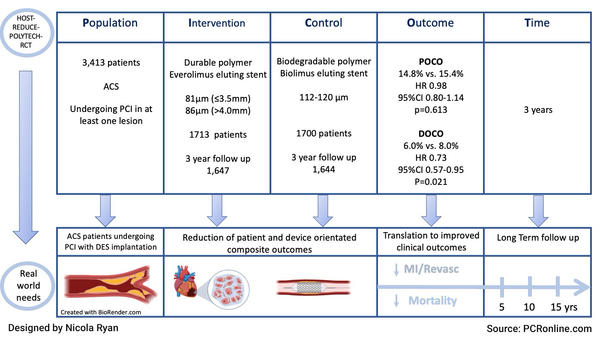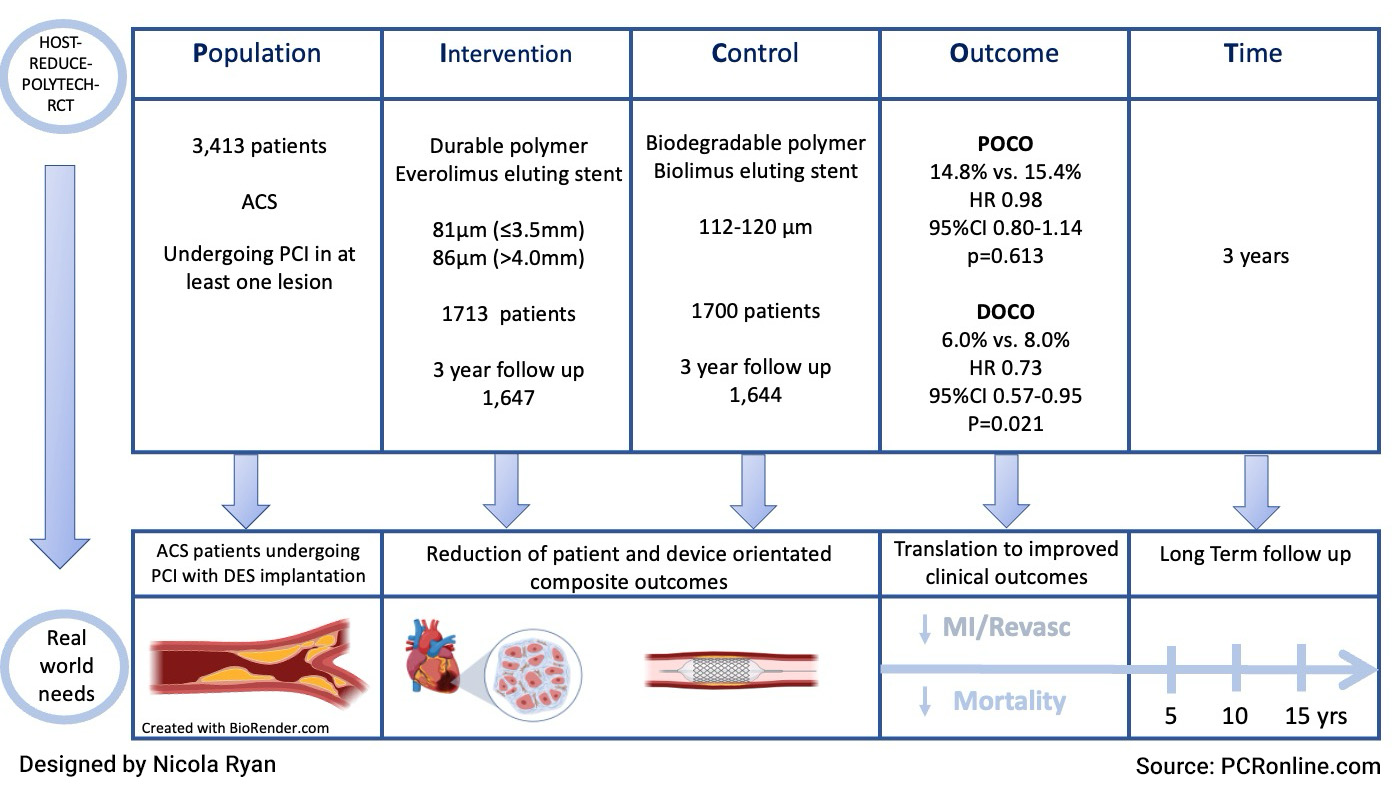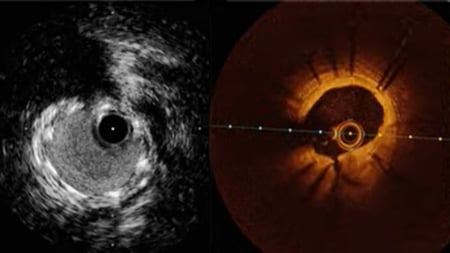20 Jun 2024
Durable-polymer versus biodegradable-polymer drug-eluting stents in acute coronary syndromes: three-year outcomes of the HOST REDUCE POLYTECH RCT Trial
Selected in EuroIntervention Journal by N. Ryan
This trial found that, in ACS patients undergoing PCI, DP-DES and BP-DES had similar patient-oriented outcomes at three years, but BP-DES had higher device-oriented composite outcomes, mainly due to increased TLR risk.
References
Authors
Jeehoon Kang, Doyeon Hwang, Kyung Woo Park, Jung-Kyu Han, Han-Mo Yang, Hyun-Jae Kang, Bon-Kwon Koo, Young-Hyo Lim, Jay Young Rhew, Kook Jin Chun, Bong Ki Lee, Sanghyun Kim, Jang-Whan Bae, Hyo-Soo Kim, on behalf of the HOST REDUCE POLYTECH RCT Trial investigators
Reference
10.4244/EIJ-D-23-01053 • JUN 17, 2024
Published
June 17, 2024
Link
Read the abstractReviewer
My Comment
The HOST REDUCE POLYTECH RCT trial was a randomised, parallel-group multicentre trial with a 2 x 2 factorial design testing two independent hypotheses, one of which was the non-inferiority of durable-polymer drug eluting stents (DP-DES) to biodegradable-polymer drug eluting stents (BP-DES) in patients with ACS. The authors report the three-year outcomes of the HOST REDUCE POLYTECH RCT trial.

PICOT overview of the HOST REDUCE POLYTECH RCT trial - Designed by Nicola Ryan - Source: PCRonline
Why this study – the rationale/objective?
Drug eluting stents (DES) are currently the gold standard for patients undergoing percutaneous coronary intervention; however, there remains a not insignificant rate of adverse events, 2-3 % per year. Advances in stent design, one of which is the use of biodegradable polymer, aim to reduce adverse events. A potential advantage of the biodegradable polymer is that, after drug elution, the polymer degrades, leaving behind a bare metal stent, thus the local inflammatory reaction and consequent increased risk of stent thrombosis is reduced compared to a durable polymer.
The one-year results demonstrated the non-inferiority of DP-DES to BP-DES with regard to patient-orientated clinical outcomes with a lower risk of device-orientated composite outcomes in the DP-DES group. Polymer degradation occurs between 4-15 months post PCI; considering this, and the fact that one-year outcomes may be influenced by choice of anti-platelet agent, it is of interest to understand the longer term outcomes by polymer type.
How was it executed – the methodology?
Patients undergoing angiography acute coronary syndrome with one lesion > 50 % deemed to require treatment with DES were eligible for inclusion in the HOST-REDUCE-POLYTECH-RCT trial. Patients were randomised 1:1 to the DP-DES or BP-DES group.
- The primary outcome was a patient-oriented composite outcome (POCO); a composite of all-cause death, non-fatal MI and any repeat revascularisation at 3 years.
- The secondary outcome was a device-orientated composite outcome (DOCO); a composite of cardiac death, target vessel MI and TLR at three years.
- Stent thrombosis, TVR and non-TVR were evaluated.
What is the main result?
Overall, between September 2014 and December 2018, 3,413 patients were included in the trial, 1,713 randomised to DP-DES, and 1,700 to BP-DES. Three-year follow-up was available in 1,647 and 1,644 patients in the DP-DES and BP-DES groups, respectively. Slightly more than three quarters of patients were male, with a mean age of 63 years, and high rates of common CVFR, including diabetes in just under half the population. The LAD was treated in half the population, with IVUS used in 30 % of cases at the operators discretion.
- There was no difference in the POCO at three years; DP-DES 14.8 % vs. BP-DES 15.4 % (HR 0.96, 95 % CI 0.80-1.14, p = 0.613).
- The risk of DOCE was lower in the DP-DES group 6.0 % vs BP-DES group 8.0 % (HR 0.73, 95 % CI 0.57-0.95, p = 0.021)
- Landmark analysis of the DOCO demonstrated that the main difference in DOCE was due to events in the 240-480 day period (transition period approx. 8-16 months post PCI)
- Early period DOCE up to 240 days DP-DES 2.0 % vs. BP-DES 2.6 %, p = 0.233
- Transition period DOCE 240-480 days DP-DES 1.8 % vs. BP-DES 3.3 %, p = 0.007
- Late period DOCE > 480 days DP-DES 2.2 % vs. BP-DES 2.2 %, p = 0.978
Critical reading and the relevance for clinical practice
The results of this 3-year follow show that, in patients with ACS undergoing PCI, DP-DES and BP-DES had similar outcomes in terms of patient-orientated clinical outcomes at three years. However, there was an increased rate of device-orientated composite outcomes at three years in the BP-DES group, mainly driven by increased risk of TLR in the BP-DES group (HR 0.61, 95 % CI 0.42-0.88, p = 0.008). In order to better understand the differences in DOCO between groups, the authors carried out a post-hoc landmark analysis, which demonstrated that the difference between polymers appeared to be driven by increased risk of DOCE in the transition period, 8-16 months post PCI, in the BP-DES group.
Multiple factors influence the outcomes after implantation of DES, including technical factors related to both implantation and stent design, clinical presentation, lesion characteristics and medical therapy. Disentangling the individual contributions of each component can be difficult, and in this analysis, the authors attempted to assess the contribution of polymer design to outcomes in ACS patients. The biodegradable polymer design is of interest due to a potential reduced local inflammatory reaction and reduced risk of stent thrombosis compared to a durable polymer.
However this analysis demonstrates that during the transition period, there is an increased risk of DOCE in the BP-DES group. During this period, the biodegradable polymer is degrading and the bare metal struts are exposed, likely leading to inflammation and increasing the risk of neointimal hyperplasia or thrombosis.
Stent strut thickness is another aspect of the stent design which may contribute to adverse outcomes. The authors hypothesised that the thicker struts of the initial generation BP-DES may have contributed to the increased DOCE; however, a sensitivity analysis excluding thick struts demonstrated consistent results.
As with any analysis, there is a number of limitations which must be borne in mind; most importantly the randomisation to polymer type, which is one feature of stent design, rather than specific stent technology. Furthermore the landmark analysis was post-hoc, therefore can only be considered to be hypothesis-generating.







1 comment
Yes